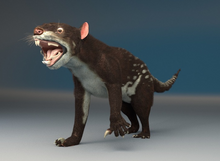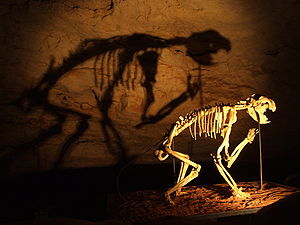Thylacoleo carnifex
The marsupial lion (Thylacoleo carnifex) is an extinct species of diprotodont marsupial of the Thylacoleonidae family. Its name meaning "lion with butcher bag" (from the Greek terms thylakos - bag, leo - lion, and the Latin carnifex - executioner, butcher). It was a carnivore whose fossil remains come from Australia, dating from the early to late Pleistocene epoch (1,600,000–46,000 years).
Unlike other carnivorous marsupials such as the Tasmanian wolf or the Tasmanian devil, the marsupial lion did not belong to the order Dasyuromorphia, but is a representative of the diprotodonts (Diprotodontia), a group to which they also belong within different families kangaroos, koalas and wombats.
The evolutionary line of thylacoleonids diverged from that of other diprotodonts about 24 million years ago, during the Oligocene, when the shift from vegetarian to omnivorous and later carnivorous diets began to take place. Forms in this family were small in size and tree-dwelling until the late Pliocene, about 2 million years ago, when a drier climate reduced the extent of Australia's primeval forests and replaced them with bushveld. The last species of the group, Thylacoleo carnifex, thrived in this habitat.
Anatomy
Marsupial lions were quadrupedal carnivores 75 cm tall and 151 cm long, about the size of a large leopard. These measurements may seem modest, but within marsupials (which tend to be smaller than their placental counterparts, due to their particular development system), they are quite respectable. In fact, the marsupial lion is the largest carnivorous marsupial known, leaving aside the largest representatives of the order Sparassodonta such as Proborhyaena and Thylacosmilus from South America, which sometimes they are not considered true marsupials, but close relatives of them. With a strong build, the weight of the marsupial lion is estimated at 130 kg (some skulls indicate that some individuals weighed 163 kg, like a jaguar).
The strangest features of the marsupial lion are found in the jaws, and are due to its primitive herbivorous origins. Due to their herbivorous diet, all Oligocene diprotodonts had long since greatly reduced or lost their tusks, and the thylacoleonids did not regrow them. Instead, the incisors and premolars became sharp and began to fulfill the function of capturing and killing prey. The jaw was exceptionally robust and it has been calculated that the bite pressure of a 100 kg individual would be comparable to that of a 250 kg African lion, making Thylacoleo the marsupial with the most powerful bite in relation to its size that has ever existed. This allowed it to kill prey much larger than itself, such as the large kangaroos of the sthenurine subfamily or even the Diprotodon, the largest marsupial that has ever existed, slightly larger than a white rhinoceros..
The tail was quite long and thick, probably to help balance the animal while running, and the body was short, with a broad chest of massive muscles. The four legs were of a similar length, although the muscles on the forelegs were more developed, as they served to grasp prey before biting its throat, as big cats do today. As for the feet, they supported themselves completely during the march, that is, they are plantigrade, as occurs in bears or humans, and not on the fingers, as in cats and canids. From their arboreal ancestors they kept an opposable toe on each foot, the two on the hind feet were devoid of nails, but the ones on the forelegs were crowned with an enormous curved claw that they used to cling to the bodies of their victims, along with those of their own. the other four fingers.
Behavior
The proportions of the marsupial lion's limbs and the distribution of its muscle mass indicate that, while it was a powerful animal, it was not a particularly fast runner. Paleontologists surmise that it must have been an ambush predator, either stalking its prey and then pouncing on it, or leaping from tree branches. This would have allowed it to capture the large animals of its time such as Diprotodon and the giant browsing kangaroos such as Sthenurus and Procoptodon. Despite its size it may not have been a true apex predator as it shared at least part of its range with the great monitor lizard Megalania up to 6 meters in length. The marsupial lion may have stored its prey in trees in a similar way to modern leopards. Like many predators, it was probably an opportunistic ghoul, feeding on carrion and driving lesser predators away from its prey.
CT scans of a well-preserved skull have allowed scientists to study internal structures and create a cast of the brain showing surface features of the animal's brain. The parietal lobe, visual cortex, and olfactory bulb of the cerebrum were enlarged indicating that the marsupial lion had a good sense of hearing, sight, and smell, as might be expected of an active predator. It also had a pair of blind channels within the nasal cavity which were probably associated with pheromone detection like in the Tasmanian devil. This indicates that it most likely bred in certain seasons and could sniff out a potential mate.
Causes of extinction
The habitat of these animals was the woodlands that covered central Australia during the Pleistocene. In the last times of this period, the climate became drier and the savannahs were gradually replaced by steppes and deserts, which caused a decrease in the herbivorous animals that lived in this environment, such as stenurines and diprotodonts, as well as their predators.. Also research on its biomechanics shows that the animal was highly specialized in hunting large game - which would have made it inefficient at catching small species, which would have contributed to their extinction as environmental conditions changed. At first, the extinction of the marsupial lion was dated 50,000 years ago and was attributed exclusively to the consequence of these climatic changes, since there was no evidence that other competitors had appeared in Australia at that time.
However, evidence has subsequently been found that marsupial lions survived for around 20,000 more years, and that humans had already arrived in Australia 50,000 years ago or even earlier. It has even been pointed out that the description of some beasts present in legends of the Australian aborigines coincide vaguely with what is known of the marsupial lions. Although today climate change is still considered the main cause of the decline in the prey of this animal and therefore its extinction, it is also highly probable that these were accelerated by the arrival on the island of Homo sapiens about 45,000 or 50,000 years ago; the human impact seems to have occurred not only from the direct hunting of the marsupial lions but also because the human presence would have favored an early desertification of much of Australia.
In January 2007, scientists in Australia discovered fossils of 70 species that lived between 200,000 and 800,000 years ago, including eight previously unknown types of kangaroos and the first complete skeleton of a marsupial lion. The finding, reported in the scientific journal Nature, adds valuable information to the debate about why so many large mammals have gone extinct in Australia. The skeletal remains located in caves under the Australian Nullarbor desert correspond to 69 species of vertebrates and one mollusk. Among the fossils are 23 types of kangaroos - eight of which have never been described - wombats, parrots and the first known complete skeleton of the marsupial lion Thylacoleo carnifex. The species found by the scientists, led by Gavin Prideaux of the Western Australian Museum in Perth, Australia, ranged from bettongs, small rodents, to 3-metre specimens.
Contenido relacionado
(39) Laetitia
Lucy
(116) Sirona



